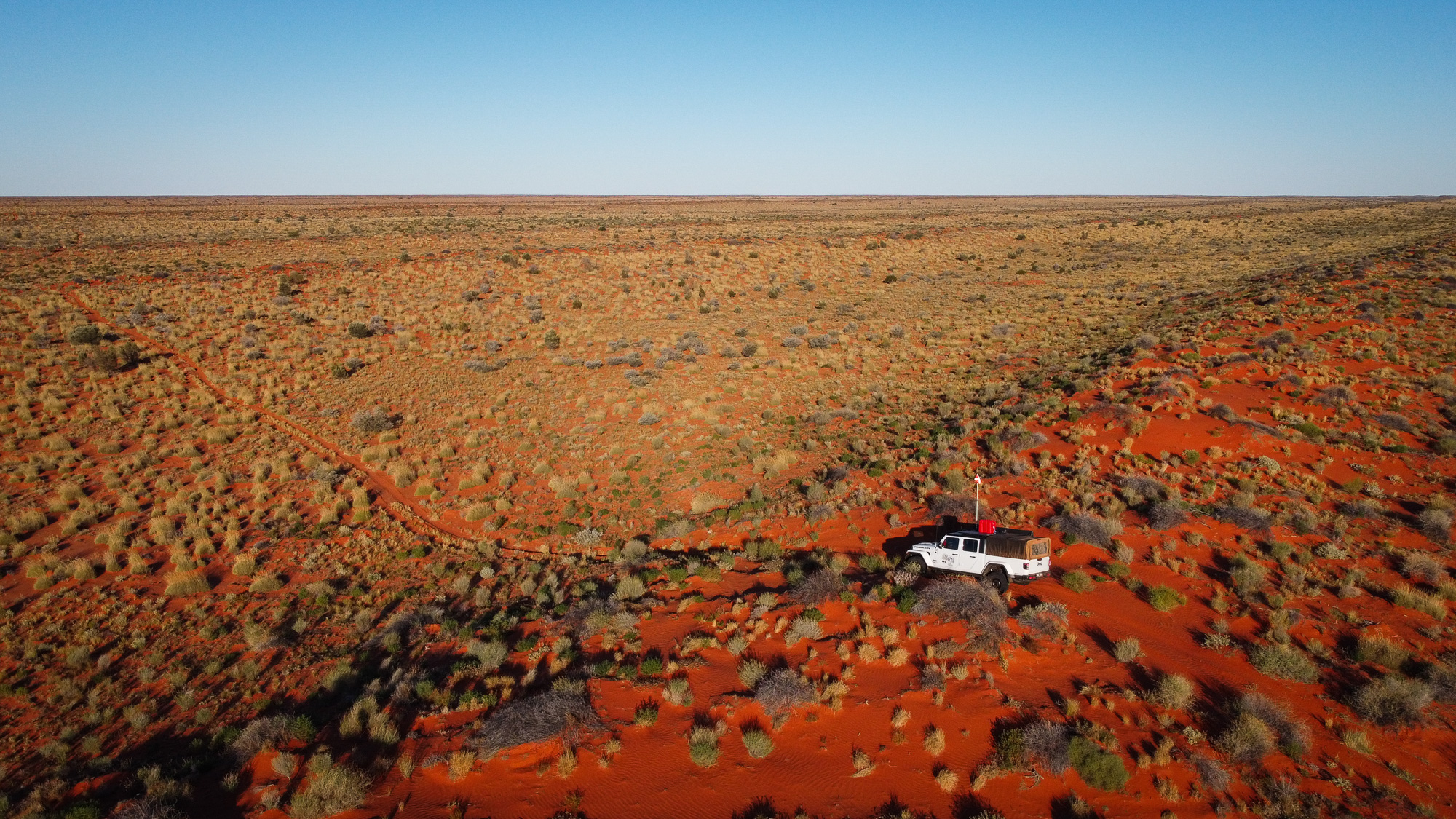I wake with a splitting headache, my body hurts all over, and I feel disconnected from reality. It takes a full 20 minutes to overcome heavy lethargy before I can crawl out of the swag and confirm Katie feels no better. With nets over our heads to block the unrelenting blowflies, we only feel worse while trying to eat breakfast half an hour later. Although it feels similar, somewhere in the dark corners of my mind, I know this can’t be malaria again.
I begin to list our symptoms out loud. We both have severe headaches, joint pain, sore throats, and dripping noses. We’re both experiencing brain fog and feeling strongly disconnected from our bodies as if we’re watching ourselves from a few paces away. This combination of symptoms sounds very familiar.
I find a rapid antigen test in the first aid kit, and after struggling with the instructions for 15 minutes, I confirm the bad news. We’re in one of the most remote places on the planet, and we have Covid-19.
After hundreds of hours of planning, preparation, and meticulous calculations for the longest and most challenging desert crossing of my life, the unexpected has reared its head—things have just taken a turn for the worse.
The Madigan Line
In the winter of 1939, Cecil Madigan, along with nine men and a camel train, set out to cross the heart of the Simpson Desert, a feat never before attempted by Europeans. Nobody knew what Madigan would find or if a crossing was even survivable. The successful expedition cemented his name in history as one of the great explorers of Outback Australia, and the route he pioneered through endless sand became known simply as the Madigan Line.
Eighty years later, Madigan’s famous route is little more than a series of GPS waypoints and has become the pinnacle of remote desert crossings in Australia and even the world. The track requires traversing more than 1,300 sand dunes and passes no town or development of any kind. Despite being larger than Florida, the Simpson Desert has a population of zero—humans, that is.
There are no wells for drinking water and certainly no fuel stations. Without a doubt, the Simpson demands respect.

To Cross the Simpson Desert
The Madigan is not a popular route, and because vehicles must travel from west to east, it is unlikely we will encounter another vehicle on the 7- to 10-day journey. We must be entirely self-sufficient.
I designed and built my Jeep Gladiator Rubicon [“Feature Vehicle,” Dan Grec, Summer 2022 issue] specifically for the Australian Outback, and the modifications and systems have performed flawlessly to date. In preparation for the Simpson, Katie and I have practiced recoveries in soft beach sand and traversed hundreds of sand dunes. The Jeep has never given me a second of doubt, and we have come to trust our lives to this vehicle.
I’ve been running the calculations for fuel, drinking water, and food for weeks, aiming to strike a delicate balance. While I’m confident we can carry enough fuel, we don’t have the capacity to carry drinking water or food for more than 10 or 12 days at a stretch. While we aim to enjoy our time in the desert, I’m also aware of the need to keep moving.
In addition to the 15-gallon drinking water tank and 3-gallon shower, we add 5 gallons of emergency drinking water and store it in the passenger compartment in two rugged containers, insurance in case of a puncture or pump failure in the main tank. In Alice Springs, literally the middle of nowhere, we fill the fridge and drawers with as much food as we can carry.
I’ve seen the Gladiator’s consumption climb as high as 8.5 mpg in soft sand, which multiplies out to a lot of fuel to cover nearly 500 miles across the desert. As an added complication, we can’t buy or carry regular unleaded gas in Central Australia. For decades, sniffing gas was a major health crisis in remote communities, so crafty chemical experts replaced the aromatics in unleaded gas with chemicals that can’t be inhaled. This low aromatic unleaded fuel has transformed previously decimated communities, and for obvious reasons, regular gas is now illegal. Real-world reports of running this gas in fuel-injected engines vary widely, although chemical experts confirm worse than typical consumption.
With two gas tanks, the Gladiator carries 40 gallons, and the bed is able to accommodate two 5-gallon jerries between the kitchen and drawers. I strap three more onto the roof rack, giving a total of 66 gallons, an expensive fill-up at $6.30 USD per gallon.
Into the Simpson Desert
South of Alice Springs, the corrugations on the Finke Road get progressively worse until hours later, we bump forward exclusively in first and second gear, mindful of the additional weight on the roof. We camp the night at the famous Mt. Dare Hotel, one of the most remote and iconic Outback pubs on the continent. For those entering the Simpson, this is the last outpost of civilization and a final opportunity for supplies and fuel. For those finishing the crossing on the more popular French and QAA routes, this is the perfect watering hole to kick off a celebration, and plenty of drinks are poured long into the night.
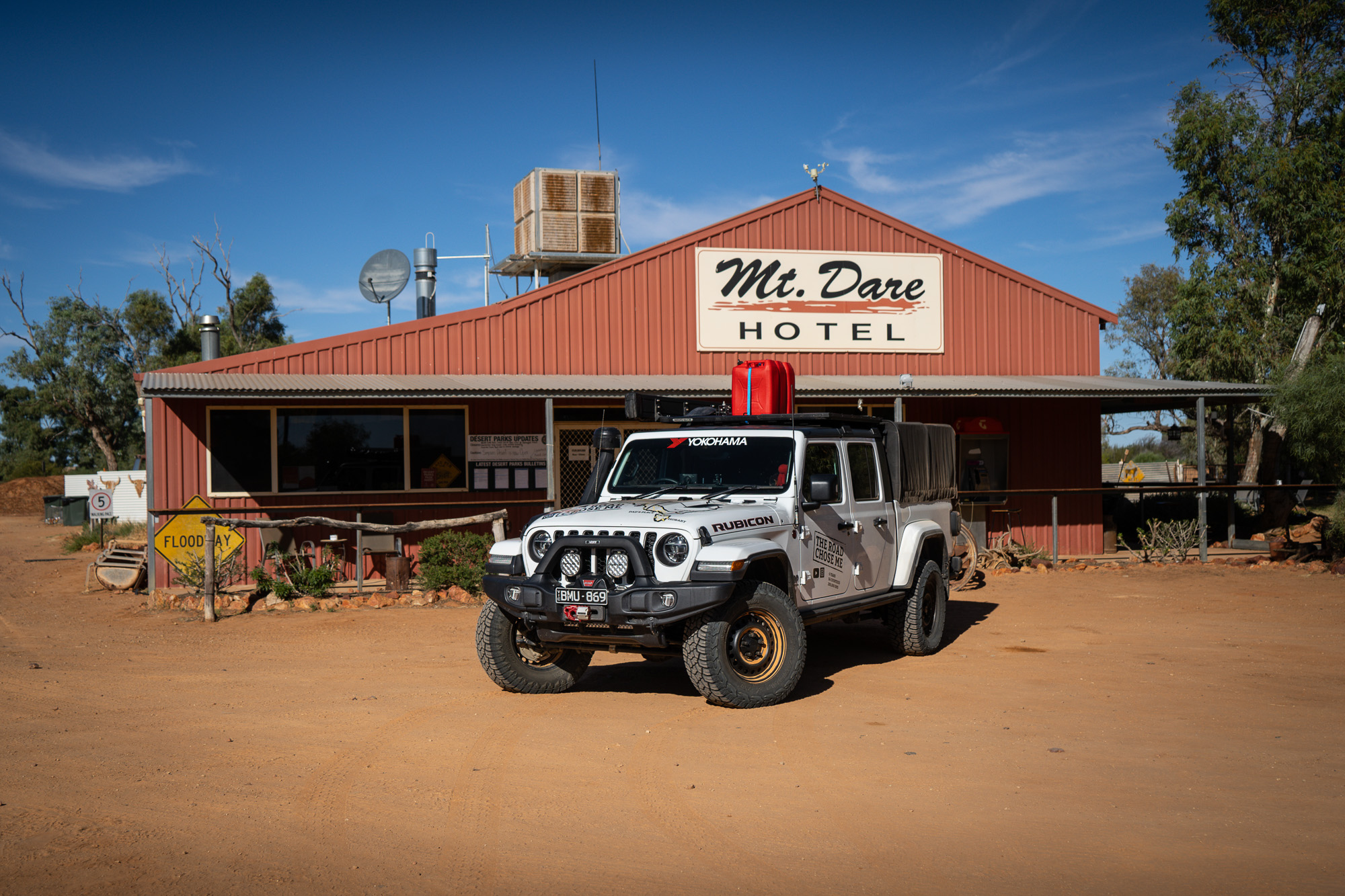


In the morning, I top off the main tank and lower tire pressures to 20 psi all around, expecting rough roads in the short term while knowing I can go much lower if and when the sand becomes seriously soft. There’s no doubt lower pressures would provide more grip in the soft sand, though it would also result in higher fuel consumption. As always, I’m hyper-aware of the need to balance our precious resources.
Let the Dunes Begin
We travel on good gravel roads for a couple of hours before arriving at the abandoned cattle station of Old Andado. Wandering through the ruins, it’s hard to imagine living this far from the world on the edge of survivability. Nearby, a bright red dune stands tall, clearly marking the beginning of the desert.
Bursting with excitement and a touch of anxiety, I can’t help but count “one” out loud as we climb up and over the first big dune. Created over millions of years and continually shifting in the wind, the dunes of the Simpson are the longest in the world, stretching in a near-perfect straight line for over a hundred miles. Like much of inland Australia, the bright red coloring is created by rusting iron ore within the sand.
The immense dunes run from north to south, meaning we must climb directly up and over every single one as we push east. The dunes vary in height from 70 to 120 feet and are spaced consistently across the desert floor, with a few hundred yards of flat sand in between. After the excitement wears off, we settle into the routine that will define the next week of our lives. For 10 or 15 seconds, we crawl slowly up the soft face of a dune, aiming to carry just enough speed to make the crest without breaking traction and tearing up the sand. Most dune faces are so steep we see nothing but blue sky and must trust the track will continue. At the top, we pause briefly to take in the view before coasting down and across the desert floor to begin all over.
I find myself inching higher and higher in my seat, attempting to peer over the tip of the hood, hoping to glimpse the track as early as possible. On many dune crests, I scramble into a sharp turn in the track that is revealed only after the nose of the Jeep comes down.
After 30 minutes, I lose count of the dunes we’ve crossed, focusing on the task and hand while absorbing the immense nothing surrounding us. There are no buildings, no side trails, and only the occasional stand of scraggly mulga trees on the flat desert floor. The track we follow is windblown and faint and is littered with animal tracks, big and small. The incessant drifting sand makes it difficult to estimate, though it could easily be a week since another vehicle passed. With plenty of contact patch, thanks to the low tire pressures, the Jeep has no trouble maintaining forward momentum as we slowly inch across the sand.
For our first night, we stop beside a massive dune at Camp 1A, the first of Madigan’s original campsites, which are all marked with a small post and placard, a constant reminder we are following in the tracks of a bonafide legend. Blowflies are a continuous battle in the Australian Outback and can be bad enough to drive a person mad. In a desperate search for moisture, flies swarm into the corners of our eyes and mouths. While they don’t bite, their unceasing companionship quickly tears nerves to shreds and makes eating an unpleasant affair.

Mercifully, the flies vanish after dark so we can fully appreciate the stunning display of stars, easily the best I have seen. Thanks to the tilt of the earth, the Southern Hemisphere faces the galactic core, resulting in breathtaking nighttime entertainment. I sit for hours trying to take it all in while Katie puts herself to bed early with a headache and sore joints.
Unknown Unknowns
Getting into Australia was a nightmare, thanks to the global pandemic. Australia did their best to keep the virus out of their island refuge, implementing the world’s strictest quarantine. Even with my Aussie passport, there was a mountain of regulations to overcome, and we were forcibly locked in a hotel room for two weeks. For months, we couldn’t legally leave the state of Victoria, and for weeks, we couldn’t even leave my dad’s house. Thankfully, all of that is behind us, and recently, we have been thinking we might never get Covid-19.
I’ve done my best to plan for known unknowns like tire failure, a radiator puncture, or personal injury, and now it is the unknown unknown of Covid-19 that has blindsided me. Of all the places I thought we might be susceptible to the virus, one of the least populated regions on Earth was never on my list. We must have picked it up in Alice Springs, and only now are our symptoms kicking in. Over the next hour, we talk around our predicament, trying to come to a decision. It proves no easy task given our extreme lethargy and increasing brain fog.
With a positive test, we are now required by law to self-isolate for seven days and are not permitted to go into a town or even stay in a campground or hotel. Our only legal option is to make camp somewhere away from people and attempt to pass the time while hiding from the relentless flies and sun. At the end of our isolation, we would then have to drive two days back to Alice Springs to re-supply, then two more to get back to where we are currently sitting. Our other option is to keep going.
We’ll be all alone for the next 7 to 10 days anyway, and we’ve enough supplies for a rest day or two if push comes to shove, so in a strange twist of fate, the desert is actually the perfect place to isolate. With our aching bodies, neither of us loves the thought of continuing on the extremely rough sandy track, but we downright loathe the idea of sitting around for seven days doing absolutely nothing in the hot sun while the flies host endless parties on our faces. Forward it is.
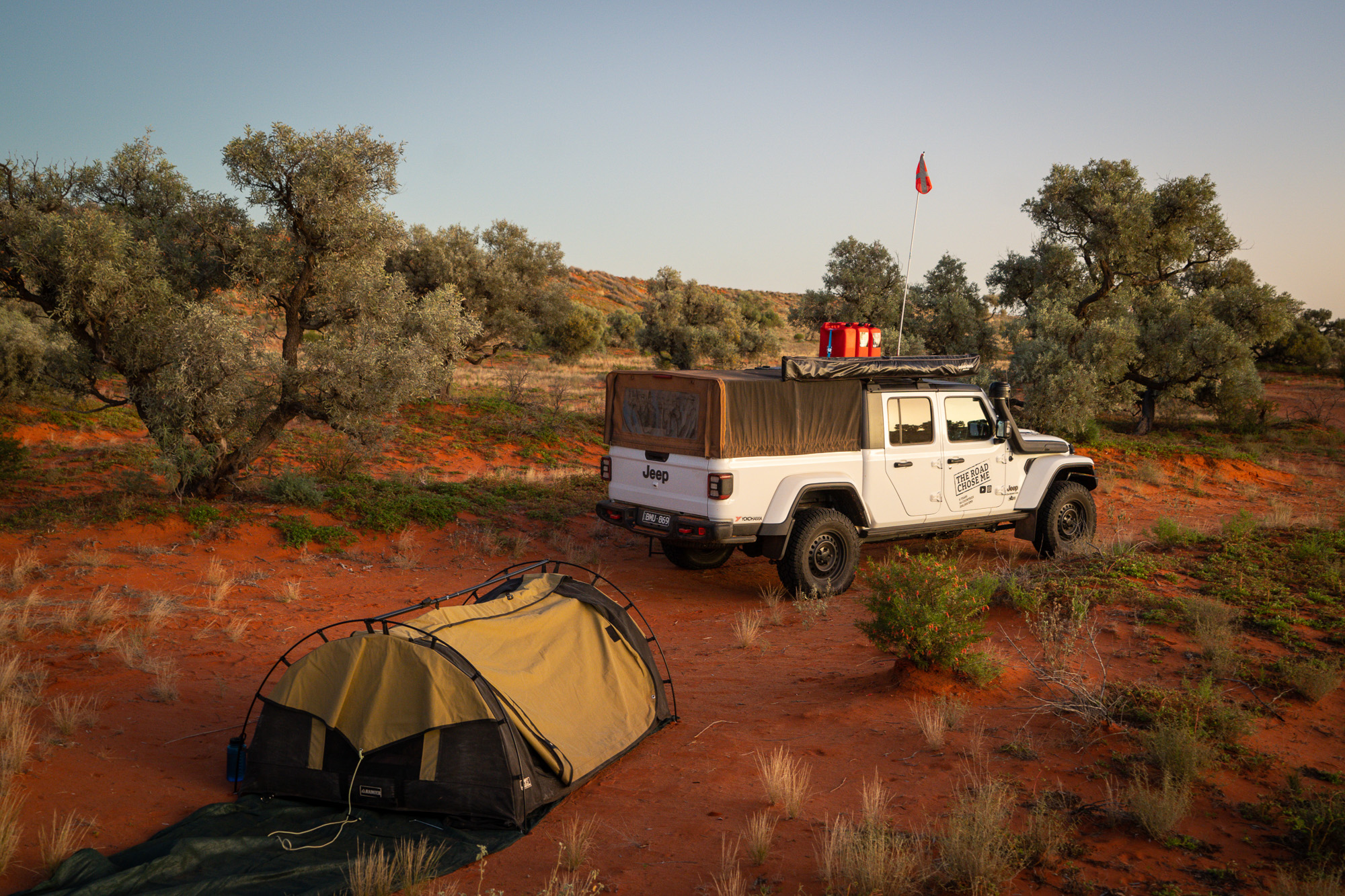
A Sea of Sand
The brain fog and out-of-body vagueness we’re feeling, combined with the isolation and repetitive desert scenery, are disorienting, and the hours blur into one giant sand dune. I feel like a cork adrift in an ocean of huge swell rolling across the desert floor. Negotiating the enormous red folds in the desert becomes our entire world, and I wonder if we’re moving across the waves at all or if we’re stuck in place while the swell slides by underneath us.
After covering two hundred miles, I’m relieved as I empty the last of the jerry cans from the roof into the primary tank, and our slow progress means I pour in the remaining two on each of the following evenings. After covering 300 miles through the desert, it’s a strange feeling to have both the main and auxiliary tanks full to the brim, and in a brief moment of panic, I worry I’ve somehow made a mistake. Struggling through the brain fog, I obsess over the numbers for hours and only begin to relax when it’s clear we have more than enough fuel to complete the crossing.
Desert Life
Recently, much of Australia has experienced higher-than-average rainfall and severe flooding. As a result, even the sparse vegetation found in the Simpson is lush and green by desert standards. Greenery clings to the dunes, including wildflowers in an array of colors. Grasshoppers and lizards of various sizes dart off the track as we approach, and each morning, our tire marks in the sand are crisscrossed with tracks, some of which obviously belong to snakes. Seemingly only active at night, we spot one large tiger snake early on in the crossing. Katie is not impressed when I casually mention that the venom can be lethal and is almost certainly so without quick access to a hospital.
From the crest of a larger dune, we spot a caravan of wild camels walking single file along the next dune in our path. There are about 10 animals of various sizes, and they don’t appear to be in any hurry. Originally brought to Australia from the Middle East to explore the vast interior deserts, camels were vital to the country’s development. Camel caravans led by Afghan traders were used until the early 20th century, and many railways and remote mining towns were built using dromedaries as the primary mode of transport.

Once their usefulness came to an end, however, the camels were let loose onto the land and are now considered an invasive pest, with more than one million animals destroying habitats and competing for food and water with native wildlife on an immense scale. Superbly adapted to harsh desert conditions, camels thrive throughout Central Australia, and despite enormous culling operations conducted by helicopter, their numbers and destruction only grow with each passing year.
We’re roughly 500 yards from the camels, so I shut off the engine and watch as they wander along the dune, slowly but surely moving closer. Always on the lookout for a leg stretch, we jump out and begin walking along the sandy track. Soon, the massive dune obscures our direct line of sight, and we’re able to get within a hundred yards. With some crafty sneaking between scrubby bushes, we creep another 50 yards, and for the first time, I can really appreciate the size of these animals. The group is made up of two enormous males escorting what I assume are six females and a couple of teenagers. When one of the males spots us, he does not react as I had been expecting, and instead of running away, he turns and walks directly toward us.
Over the next five minutes, he closes to within 20 yards before it occurs to me that this may not be such a good idea. We’re now a long way from the safety of the Jeep, and I have no idea how these wild animals will react if startled. We slowly retreat without turning our backs, and for a few hundred yards, we reluctantly play follow the leader. First, the big male and then all the others continue to walk toward us, bobbing their heads before looking at each other quizzically, sizing us up. They seem more curious than aggressive, though I’m relieved when they lose interest without incident.
Overnight, I’m woken by the loud howls of a pack of dingoes, causing my skin to tingle and my hair to stand on end. They sound close to camp, and I make out at least half a dozen separate animals, including one small pup attempting to join the pack. The nearly full moon has risen high overhead, casting bright light across the barren landscape. I lie silently awake, hoping to catch a glimpse of our visitors through the bug netting, but they remain hidden, and I never see so much as a shadow.
In the morning, I follow a maze of fresh tracks around the perimeter of our campsite, and I’m happy to see they didn’t come within 30 yards of our sleeping swag. While dingo attacks on adults are rare, with only a few documented cases in Australia’s history, this far from other people, I do feel particularly vulnerable.
Alone in the Simpson Desert
Days into the desert, we still have not seen another vehicle or heard so much as a crackle in reply to our call-outs on the CB radio. On day five, I smile as I use my signal and turn onto the Hay River Track, where we travel south for an hour before again turning east onto the Madigan.
Old barbed wire fences, sheets of corrugated iron, and the occasional pile of bones from cattle that wandered too far signal our gradual return to civilization and the Adria Downs (cattle) Station on the eastern edge of the desert. Camp is at a dry waterhole, and at dusk, we see kangaroos, a lone emu on patrol, and a flock of pelicans as they pass low overhead. All of these are sure signs of water, and I feel myself instinctively slow down, not ready for our time in the desert to come to an end.
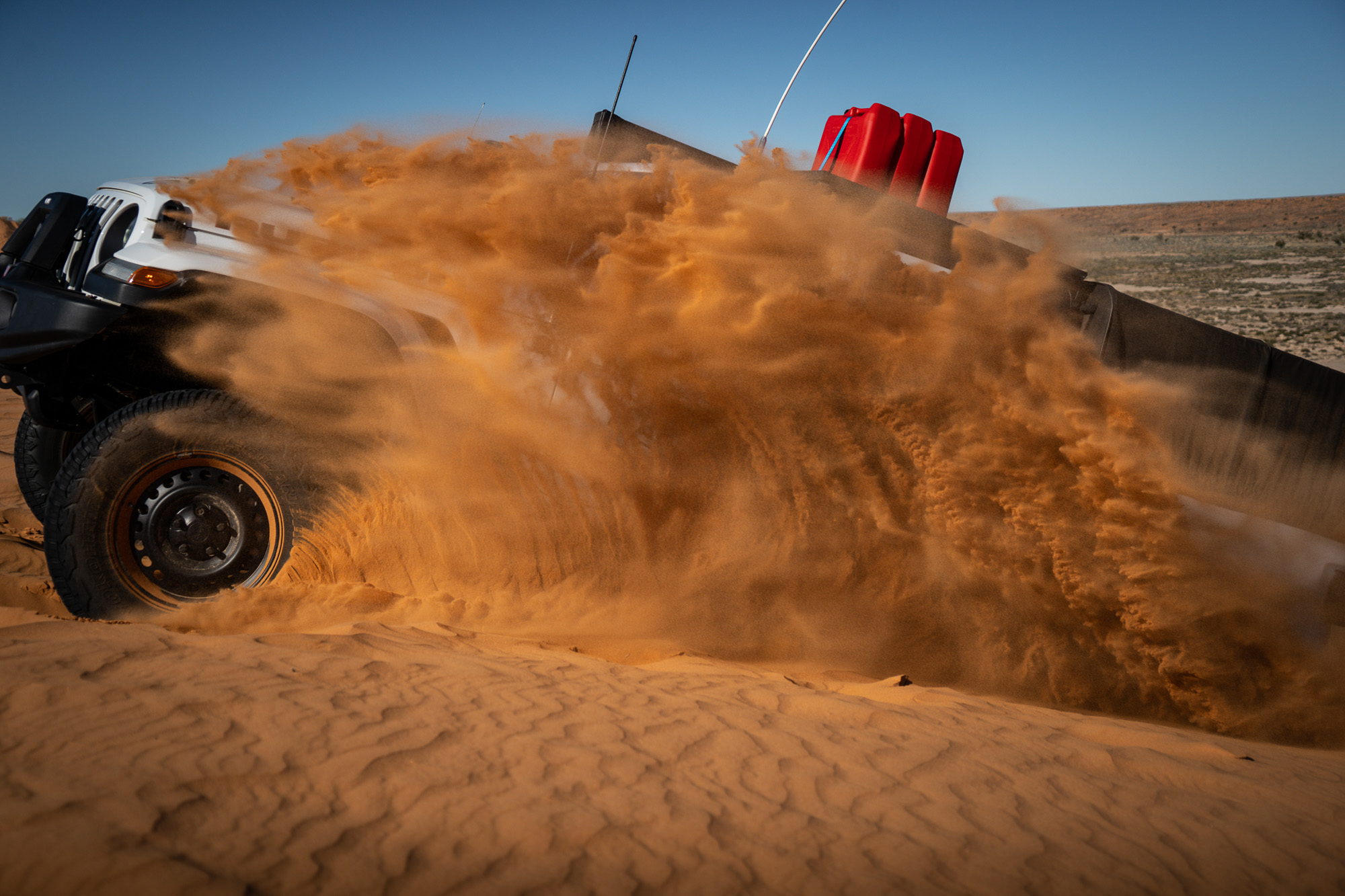
Early on the last morning, we arrive at Big Red, the most famous and possibly most sizable dune in the Simpson. There are multiple tracks up the impressive dune ranging in difficulty, and I fancy the Jeep to take on the steepest of them all. To increase grip, I further lowered the tire pressures to 12 psi. With the automatic transmission in manual mode, I quickly bump down gears as the dune gets steeper, and the Gladiator powers to the top with momentum to spare. While low-end torque and fuel economy are the distinguishing features of diesel engines, there is no doubt the superior horsepower of gas engines is by far superior for significant dune climbs.
We enjoy the stunning view and stay on the top of Big Red for almost an hour, soaking in the silence and our final moments alone in the desert. Twenty minutes later, at the edge of Birdsville, I can’t help but wave at the first vehicle we see, and with our mandatory seven-day isolation now complete, we’re free to dive in.

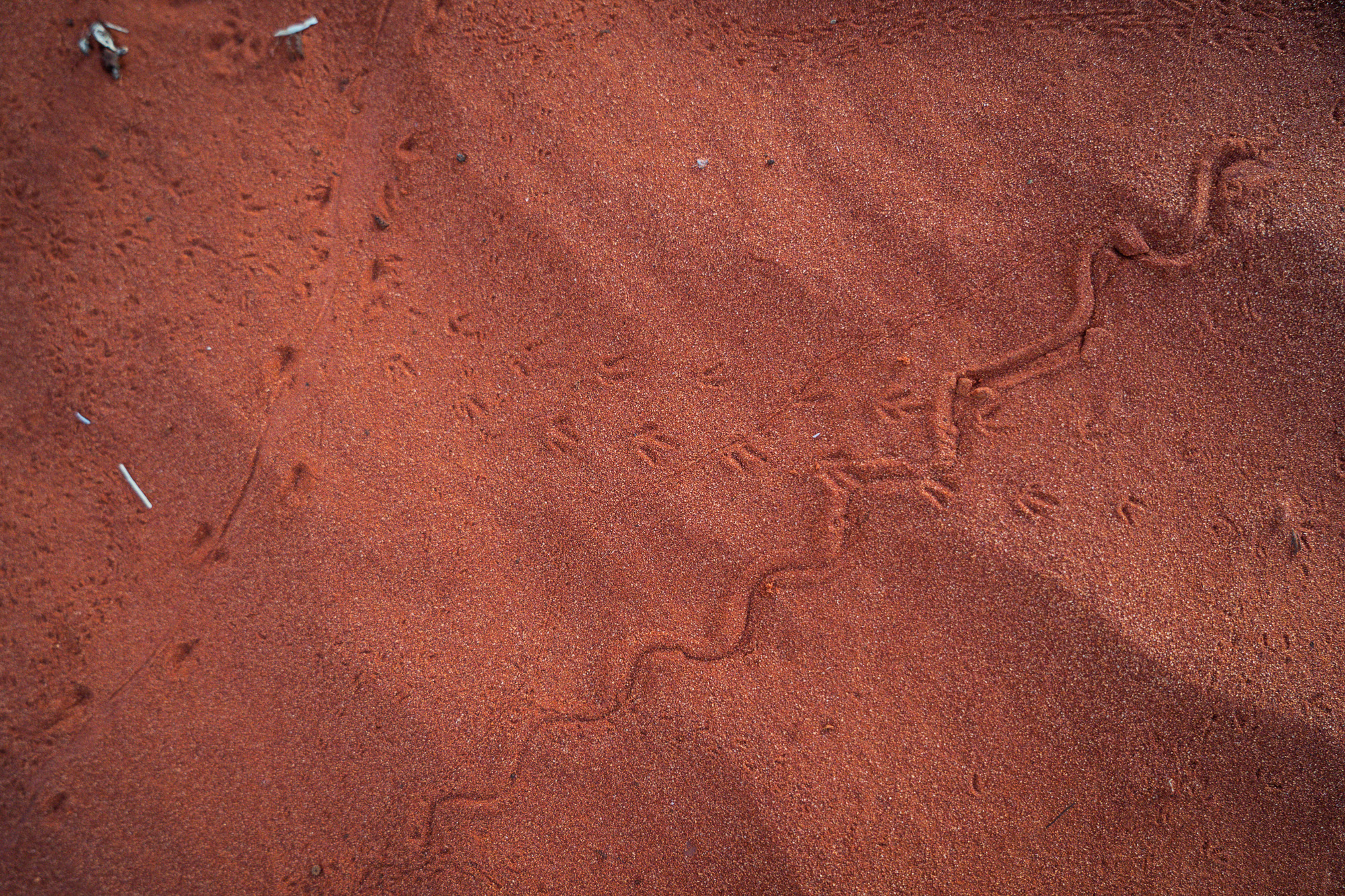
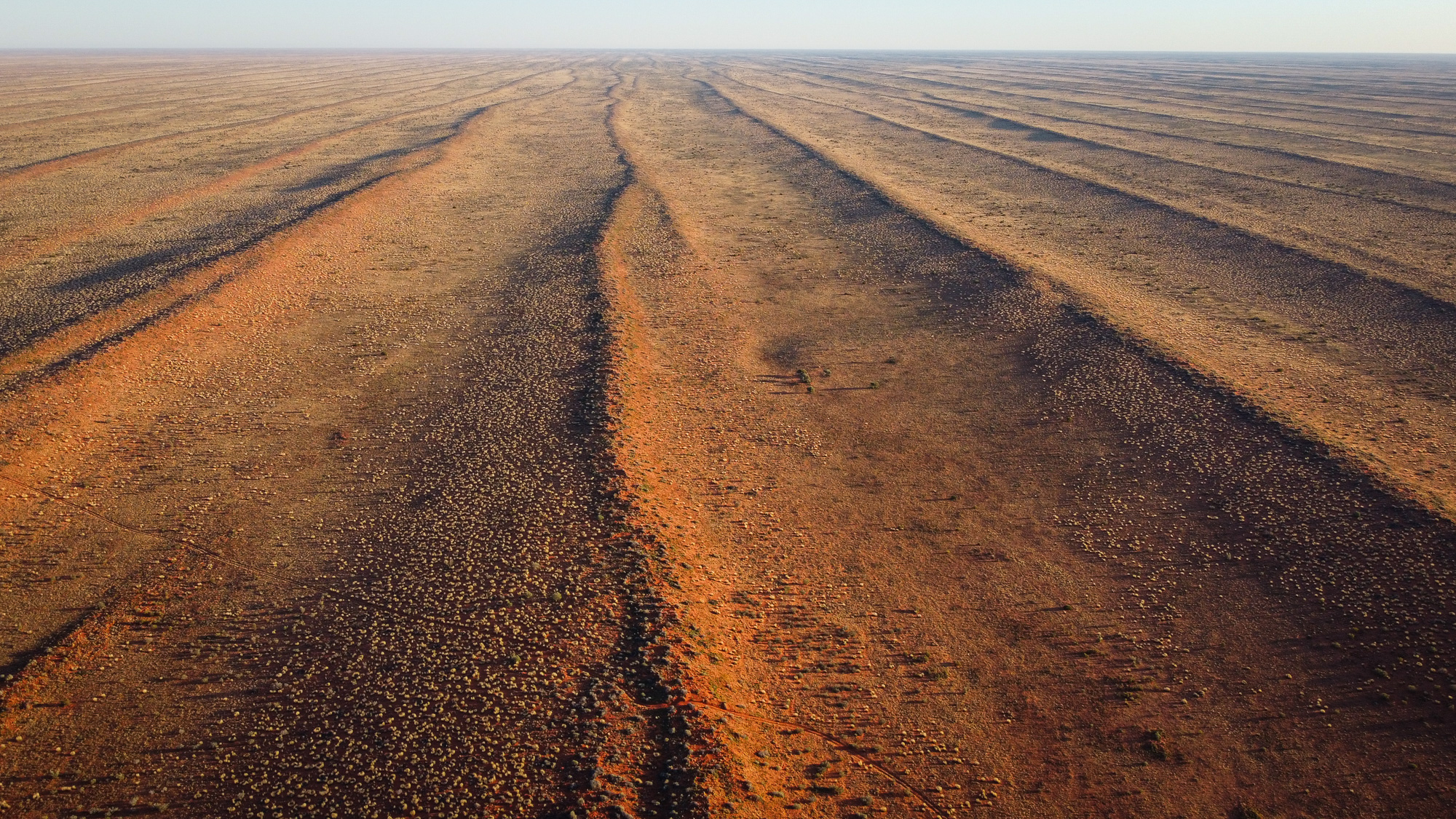
Expect the Unexpected
It took Madigan 25 days to cross the Simpson, verifying his previous conclusions that the area was a wasteland. Although his report was conclusive, in less than 20 years, the area was crisscrossed by petroleum exploration, which turned up precisely nothing.
Madigan’s pioneering use of mobile radio communication and meticulous planning meant his crossing of the Simpson by camel train went off without a hitch, and it is regarded as the last of the great Australian exploration adventures. When he emerged in Birdsville, Madigan was hailed a hero and went on to a life of research and academia, where he became an authority on central Australian geology and geography. Camping each night at one of Madigan’s original campsites gave me a strong sense of connection to his epic desert crossing, and I often found myself wondering what he was thinking about all those years ago.
Planning is all good and well, but it’s the unknowns that jump out to bite us and throw best-laid plans out the window, forcing us to adapt to changing circumstances. We covered 475 miles over seven days and crawled more than a thousand sand dunes. The solitude and vastness of the desert left a lasting impression on both of us, and it’s unlikely we will ever forget our time in the Simpson.
Isolating for seven days in one of the biggest deserts on the continent did make for a good story over cold beers at the Birdsville pub that night, and after a few pats on the back, I felt a tiny bit closer to Madigan.
As is often the case, the desert had a final trick to play. Less than 12 hours later, under police escort, we were the last vehicle to leave Birdsville through rapidly rising floodwater before the town was cut off.
Expect the unexpected, indeed.
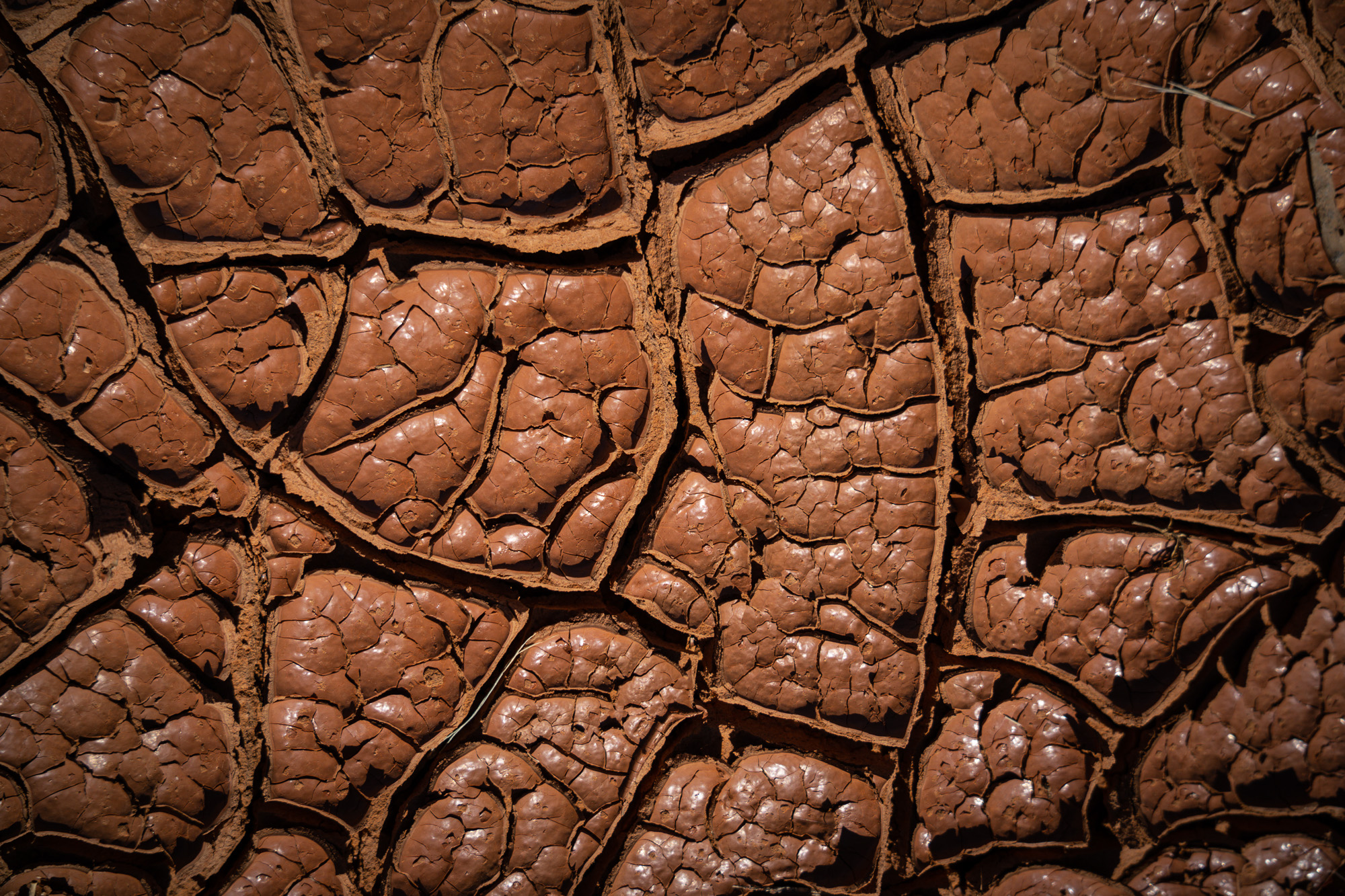
Editor’s Note: This article was originally published in Overland Journal’s Gear 2024 Issue.
Read more: The Road Chose Me: Dan Grec’s Jeep Wrangler Rubicon
Our No Compromise Clause: We do not accept advertorial content or allow advertising to influence our coverage, and our contributors are guaranteed editorial independence. Overland International may earn a small commission from affiliate links included in this article. We appreciate your support.


